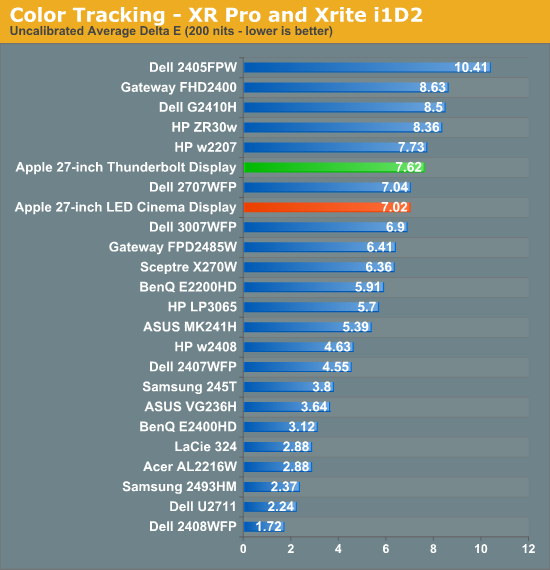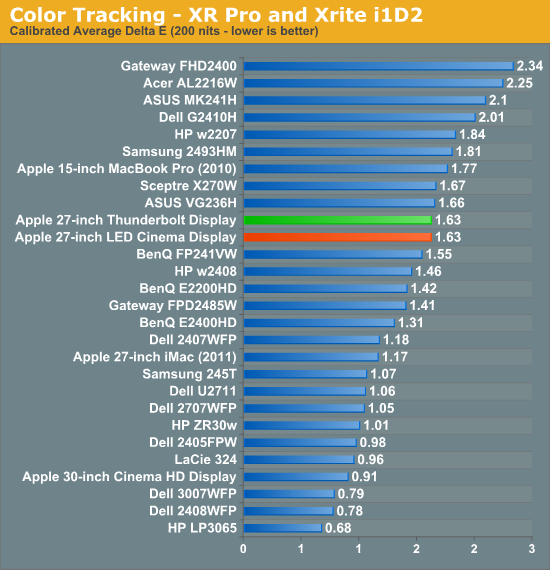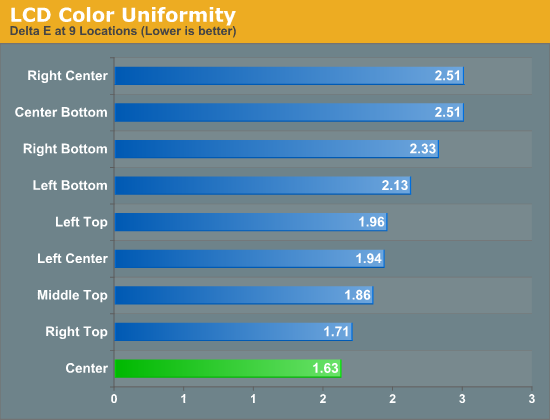The Apple Thunderbolt Display Review
by Anand Lal Shimpi on September 23, 2011 2:56 AM EST- Posted in
- Displays
- Mac
- Apple
- Thunderbolt
- Thunderbolt Display
Display Testing
With all of the extra connectivity there is to test with the Thunderbolt Display we can't forget the actual panel testing. Thankfully this part is pretty simple, the display characteristics are near identical to the 27-inch LED Cinema Display we reviewed last year.
Color Quality
We report two main quality metrics in our display reviews: color accuracy (Delta-E) and color gamut. Color gamut refers to the range of colors the display is able to represent with respect to some color space. In this case, our reference is the AdobeRGB 1998 color space, which is larger than the sRGB color space. So our percentages are reported with respect to this number, and larger is generally better.
Color accuracy (Delta E) refers to the display’s ability to display the correct color requested by the GPU and OS. The difference between the color represented by the display, and the color requested by the GPU is our Delta-E, and lower is better here. In practice, a Delta E under 1.0 is perfect - the chromatic sensitivity of the human eye is not great enough to distinguish a difference. Moving up, a Delta E of 2.0 or less is generally considered fit for use in a professional imaging environment - it isn’t perfect, but it’s hard to gauge the difference. Finally, Delta E of 4.0 and above is considered visible with the human eye. Of course, the big consideration here is frame of reference; unless you have another monitor or some print samples (color checker card) to compare your display with, you probably won’t notice. That is, until you print or view media on another monitor. Then the difference will no doubt be apparent.
As I mentioned in our earlier reviews, we’ve updated our display test bench. We’ve deprecated the Monaco Optix XR Pro colorimeter in favor of an Xrite i1D2 since there are no longer up-to-date drivers for modern platforms.
For these tests, we calibrate the display and try to obtain the best Delta-E we can get at 200 nits of brightness for normal use. We target 6500K and a gamma of 2.2, but sometimes the best performance lies at native temperature and another gamma, so we try to find what the absolute best performance could be. We also take an uncalibrated measurement to show performance out of the box using either the manufacturer supplied color profile, or a generic one with no LUT data. For all of these, dynamic contrast is disabled.

Uncalibrated performance remains fairly similar to last year's LED Cinema Display, however once calibrated the Thunderbolt Display is spot on with its predecessor:

As we mentioned earlier, a sub 2.0 delta E is good enough for professional use. Although not perfect the Thunderbolt Display falls within that range for sure.


We measured slightly lower color gamut on the Thunderbolt Display than the original LED Cinema Display, however the result was much closer to the 2011 27-inch iMac. I couldn't visibly tell any differences and Apple indicates that color gamut shouldn't have changed, so it's quite possible that the differences here are due to our colorimeter and not the panel.
Color Uniformity
Now for color consistency, we take our best calibration profile from the very center at 200 nits and test color accuracy at 9 different places around the LCD display in an evenly distributed grid. We’ve shown before that calibration is localized across the display, partly due to the brightness not being uniform, partly due to the discrete nature of the display itself.

The Thunderbolt Display was fairly uniform across its surface, something we noticed in reviewing the 27-inch LED Cinema Display last year. Uniformity is actually better on this panel than the one we reviewed last year, although in both cases I couldn't really tell any differences.
Peak brightness appears down slightly, but so are the black levels which result in a slightly better contrast ratio. Apple is also calibrating these things at the factory now so white points are now set at around 6300K vs. 7100K on the original 27-inch LED Cinema Display.










275 Comments
View All Comments
snow peak - Saturday, July 21, 2012 - link
I have similar annoying issue here, while playing songs which in iTunes on my new MBA(mid-2012) out via TB display's speaker.The audio data stream is routed from MBA to ThunderBolt display, and just one apple's USB keyboard connected to ThunderBolt display.
You might be interested in trying experiment without external storage attached on TB display, and get same result with mine.
The symptom is little static noise came with music play at beginning, and then the music gradually merged by static noise after a few of minutes or a couple of hours.
I think it caused by hardware power ground layout issue, so no confidence apple could fix it via firmware update and no idea if I should return both my new MBA and TB display.
This is really annoying!!
paulrmc - Tuesday, August 7, 2012 - link
Hi Anand,I don't know whether you looked at comparing directly connected USB drives to same drives hooked up to the TB Display. I was shocked today when I found out the difference. I'm using a USB 2.0-connected LaCie 2GB drive as a secondary drive to my dual-SSD mid-2011 Mac mini Server. Using BlackMagicDesign's Disk Speed Test I came to following results:
- directly connected to the back of the Mac mini: 29MB/sec write, 33 MB/sec read
- connected to the TB Display: 7.5MB/sec write, 11.7MB/sec read.
I'm running OS X Mountain Lion 10.8 on the mini, and the tests were repeatable, after fresh power down - reboot cycles.
Any ideas? Anyone?
Paul
hiscore - Tuesday, August 20, 2013 - link
I have just discovered the source of my Thunderbolt display distorted audio issue. It is being created by my Drobo which is interfaced through iSCSI. I can replicate the issue every time when moving files to it. Granted the files are moving from my Pegasus array, so I guess there may still be some questions.I have been in constant contact with Apple support, Promise support, and Drobo support. Hopefully a fix will be supplied from someone.
highscore - Tuesday, December 23, 2014 - link
Update:It wasn't the Drobo.
I no longer run a drobo and still encounter the issue. The problem seems to occur whenever there is high I/O through Thunderbolt. I have 3 Promise RAIDs and one Lacie 8Big all on one TB bus, with the TBD on the second bus and the problem still occurs. It really just points to a USB buffer issue. The same issue that Anandtech hypothesized in this review.
krakago - Saturday, June 7, 2014 - link
Unfortunately this display is now a dinosaur, and a very expensive one. As of 2014 there are finally more devices and computers appearing with Thunderbolt, but peripherals tend to be very expensive and meanwhile USB 3 has become pretty much ubiquitous. That makes this Apple display unacceptably crippled. If it were cheap that could be overlooked, but it sells for a premium price. I've been looking for a display to use with my Macbook Pro, and comparing the price and features of the Apple offering to their competitors I can't see a good reason to choose the Thunderbolt Display. Apple really needs to bin this thing and bring out a modern version.